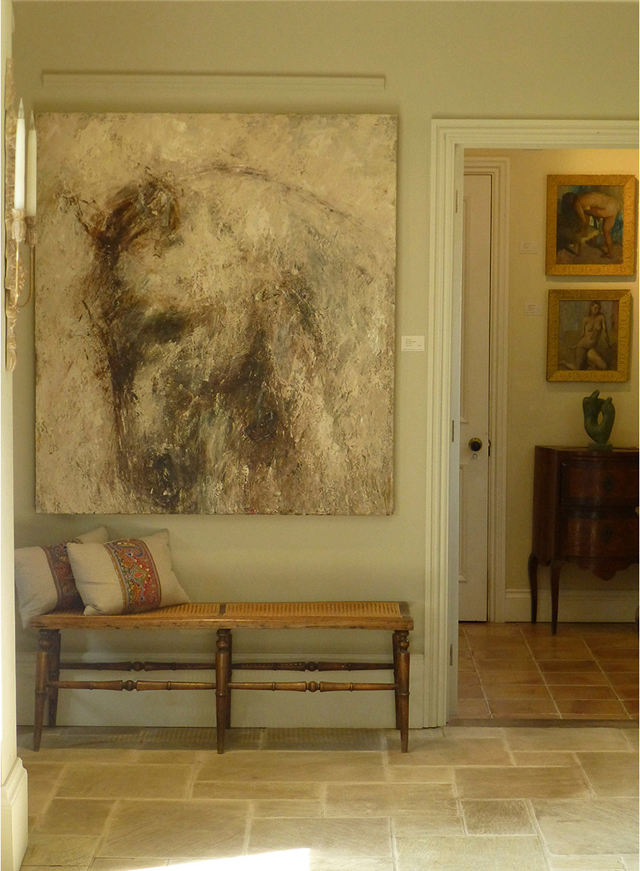How art can transform a home
Arabella Youens discovers how art can transform a house.


Less is definitely more when it comes to hanging paintings in country houses. Arabella Youens discovers how art can transform a home.
Dress for impact Hampshire-based Josie Eastwood (01962 776677; www.josieeastwood.com) is one of a younger breed of art dealers who specialise in sourcing (‘truffle hunting’) contemporary paintings and sculptures for clients who want to inject a bit of colour and dynamism into their (often period) country houses. ‘I think the soul of the room is the art and you can transform a house without lifting a paintbrush, but just by re-hanging the pictures,’ she explains.
She was recently asked to find some paintings for a house that was about to launch on the market. ‘It hadn’t been done up in about 30 years, so we went in and hung a few new paintings and it made a phenomenal difference.’
Although she stresses that she doesn’t source paintings to suit colour schemes, her approach is to visit clients’ houses to get a feel for what’s there already and advise on what else to buy or how to re-hang current works. ‘It’s my job to pull out what’s worth keeping and confine the rest to the attic. I like an eclectic mix of art—pieces that have been inherited and those bought separately can work well together.’

Changing tastes Angus Broadbent, who operates a similar service from his gallery in South Kensington, is another advocate of introducing contemporary paintings into traditional spaces (www.broadbentgallery.com; 020– 7589 3325). ‘Our parents’ generation had more regard to tradition than we do and I think that what appeals to today’s buyers is that we love the rigour of vernacular architecture—be it Georgian or Tudor—but we want to have freedom to be more adventurous.’
He was recently involved in the refurbishment of Kinross House, Sir William Bruce’s masterpiece in Kinross-shire. ‘We purposefully placed some contemporary interventions next to original works and the results are striking. They add a freshness to the interiors and, on a domestic scale, this approach works well, too.’
He adds: ‘Once, you expected harmony throughout a house—a continuity of elegance across the paintings, the architecture and the interiors. Today, people are taking a more confrontational approach and creating a more dynamic relationship between the paintings and interiors, with dramatic results.’
Sign up for the Country Life Newsletter
Exquisite houses, the beauty of Nature, and how to get the most from your life, straight to your inbox.
The art of hanging ‘Always get the most important wall covered first with the impact painting,’ says Josie. ‘Then work around it, balancing with pieces on each side, keeping the middle of the painting at the average person’s eye height.’
She advises, if hanging in pairs one above the other, always to have the larger painting on top. ‘And I’d recommend an abstract work on a high wall or stairwell—if it’s viewed from above or below, it doesn’t disturb the overall effect as much as if you’d put a landscape there.’
Dress to sell When it comes to putting a house on the market, one of the key considerations is to think about the likely buyers. According to Lindsay Cuthill, who heads up Savills country-house department (020–7016 3820), quite a bit of work (or ‘repositioning’ in his words) goes on behind the scenes before a house is launched—as long as the clients are on side with the idea.
‘As agents, we’re constantly thinking about what the majority of buyers like to see and, providing the client is happy with the idea, we try and suggest ways of providing this. For instance, if a bedroom belonging to an empty nester is still displaying tired teenage posters, we’ll take these down and exchange them for Peter Rabbit to appeal to buyers with young families. The same is absolutely true of the artwork,’ he adds.
A case in point was a house in West Kington, Wiltshire. ‘We decided to reposition the house when the owner felt the emphasis in the original marketing had been too strong on the garden, which is lovely but large, and the reception rooms, which were classical and filled with antiques. We redid the brochure, focusing this time on the kitchen, which, despite the traditional architecture of the house, is fantastically modern, and the bathrooms, which had also been recently updated. Interestingly, we’ve already had an offer on the house.’
Need to know Anyone who obtained Listed Building Consent (or had entered into written contract with a builder) for an alteration before March 21, 2012, has until September 30 this year to complete the works before they will need to pay standard-rate VAT of 20%.
‘If you’d received Listed Building Consent for an exten- sion, for example, and have yet to start the project, I’d recommend getting started as soon as possible,’ advises Crispin Mahony of Savills in Winchester (01962 834011). ‘And if you’re in the middle of a project that’s likely to go on beyond the deadline in September, it’s a really good idea to make sure your invoicing is completely up to date.’
-
 Six rural properties with space, charm and endless views, as seen in Country Life
Six rural properties with space, charm and endless views, as seen in Country LifeWe take a look at some of the best houses to come to the market via Country Life in the past week.
By Toby Keel Published
-
 Exploring the countryside is essential for our wellbeing, but Right to Roam is going backwards
Exploring the countryside is essential for our wellbeing, but Right to Roam is going backwardsCampaigners in England often point to Scotland as an example of how brilliantly Right to Roam works, but it's not all it's cracked up to be, says Patrick Galbraith.
By Patrick Galbraith Published
